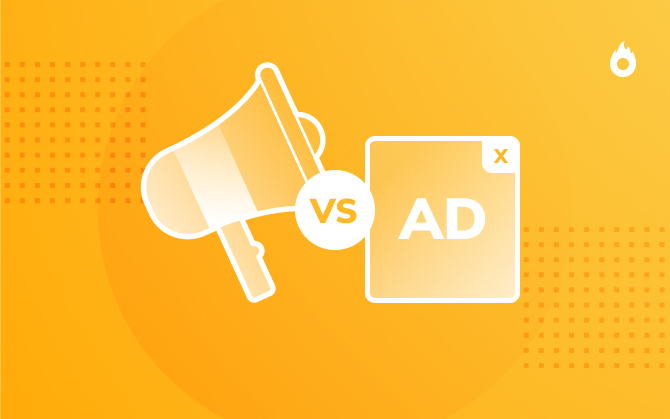
Advertising vs Marketing: What Is the Difference?
Confused over the differences between advertising and marketing? You need to know the difference if your brand is going to succeed.

What will we see in this post

Understanding the differences between advertising vs. marketing is crucial to your overall brand success. Both marketing and advertising will play a key role in attracting your target audience, building brand awareness, and ultimately in securing interaction with your products, services, or content.
This quick guide will help you better understand the differences between the two so that you can focus more productive energy into each individually. Let’s get started.
Advertising vs Marketing: Differing Responsibilities
There are unique responsibilities for both marketing and advertising. Let’s look at how these responsibilities differ.
Advertising: Advertising is a more measured, direct endeavor to present certain information to the public. Advertising responsibilities include:
- Demographic Research: This is a step that is taken to get to know the targeted audience. This information helps a brand spend advertising funds effectively.
- Advertising Pitches: The advertising department will pitch advertising campaign ideas to those in charge of approval and funding.
- Media Purchases: It is the job of advertising to be in the know on marketing channels and to understand which paid types of media will most benefit the brand.
- Managing creative production: The creative content that is used for marketing and advertising will usually be managed by the advertising department. This content is then distributed to the marketing department for distribution.
Marketing: A marketing team will focus on how to make a brand profitable from beginning to end. The responsibilities can include:
- Branding: Your brand is your personality in the market. Branding includes a vast amount of information and details. All of these work together to present you to the world. Your branding will inform customers why you are different from the competition.
- Trend Analytics: Another important responsibility of marketing is trend analysis. This branch of marketing will track your marketing campaigns, advertising campaigns, and the activity of competitors. All of this information is used to improve marketing activities for the future.
- Customer Interaction: Customer interaction is crucial in today’s world of social media marketing and instant access. Your customers have instant access to your brand via email and social media platforms. They expect that interaction should be quick and meaningful. This helps build customer loyalty as well as word-of-mouth advertising.
- Research and Development: Marketing is also responsible for research and development to perfect marketing endeavors.
Budgeting: In many cases, marketing is also responsible for budgeting and ROI monitoring.
VIDEO: Marketing strategies: 15 killer strategies to promote your business and attract customers
Advertising vs Marketing: Differing Purposes
Not only are the responsibilities different between marketing and advertising, but the purpose of each department is also different.
Advertising: Advertising will serve the purposes of:
- Keeping brand awareness in sight
- Attracting first-time purchases
- Call to purchase through ads
- Increasing brand loyalty
- Encouraging repeat purchases
Marketing: Marketing will primarily serve the purposes of:
- Customer acquisition
- Customer retention
- Lead generation
- Brand consistency
- Product development
- Monitoring results of initiatives
Advertising vs Marketing: Differing Techniques
Advertising: Advertising techniques are much more obvious and direct attempts to sell a product or service directly to the potential customer.
- Traditional: Traditional advertising techniques include print, TV, and radio.
- Retail: Another form of traditional advertising that takes place on the shelf through in-store promotions and content.
- Digital Advertising: Digital advertising should not be confused with online or social media marketing. Digital advertising consists of direct ads that are digitally displayed on various sites.
- Billboards
- Mobile ads via apps
Marketing: The techniques used by each department can also be quite different. Let’s take a look at marketing techniques that are often used.
- In-Bound Marketing: In-bound marketing attempts to attract new customers using organic methods. This means that instead of using an obvious ad, you are instead offering something useful to the potential customer that will also remind them of your brand or introduce them to your brand. For instance, a blog post on “Winterizing Your Plumbing” can provide valuable content to the user, while also introducing them to the plumbing service.
- Content Marketing: Content marketing is another technique that can be used mainly on social media outlets. This content is attractive to your demographic and will also present the brand.
- SEO: SEO, or search engine optimization, is crucial to all aspects of online marketing. All content published online should be created in such a way as to work smoothly with search engine best practices, be attractive to search engines, and avoid practices that would flag content. This will help your content rank highly on searches.
- Email Marketing: Another important technique is email marketing. Email marketing continues the customer relationship following an interaction or purchase.
- Affiliate Marketing: When brands partner up with affiliates, it produces a win-win situation. This gives you the opportunity to reach a larger audience.
VIDEO: PAID OR ORGANIC TRAFFIC: Which is BETTER if you’re just GETTING STARTED? | Hotmart Tips
Differing Investment Required for Advertisement vs. Marketing
Both marketing and advertising will require an investment of both time and money. However, there are some differences in the investment required.
Advertising: Advertising endeavors are very straightforward and are often automated after launching. Advertising will often require more of an initial financial investment, but not as much time.
Marketing: Marketing can usually be managed on a smaller budget than advertising, but in the long run, it will require more time investment. Because marketing often involves customer interaction, there is a greater need to put time into those customer relationships.
Differing Success Measurements for Advertising vs. Marketing
It’s important to always monitor the success of advertising and marketing campaigns. How that success is measured, though, can be quite different.
Advertising: Because advertising is more straightforward, the methods of measuring success are very straightforward as well.
- ROAS (Return on Ad Spend)
- Engagement
- Reach
- Conversions
- KPI (Key Performance Indicator)
Marketing: You can measure marketing success in the following ways:
- Customer satisfaction
- Sales revenue
- Lifetime value to customers
- Other methods
Differing Results Generation
Both marketing and advertising will produce results for your brand. Those results are generated in different ways, though, and will take different amounts of time.
Advertising: As we’ve said, advertising is a pointed and straightforward interaction with a customer, so the results of advertising are seen sooner, whether good or bad. You will know rather quickly if an advertising initiative is working or not. A good rule of thumb for advertising is that you should give the results the same amount of time as you gave the campaign. For instance, if you run a month-long advertising campaign, then you should also give the results a month to roll in following the end of the campaign.
Marketing: Marketing is a long-game approach. This means that marketing initiatives are intended to be long-term. The results that these long-term initiatives produce can take more time. Your expectations concerning results should be realistic.
Conclusion
Understanding the differences between marketing and advertising can help you streamline your efforts and focus time, attention, and money more accurately. If you are looking for more ways to take your brand to the next level, Hotmart can help. Download our “Buying Traffic: The Ultimate Guide for Creators and Affiliates” book for free!”






